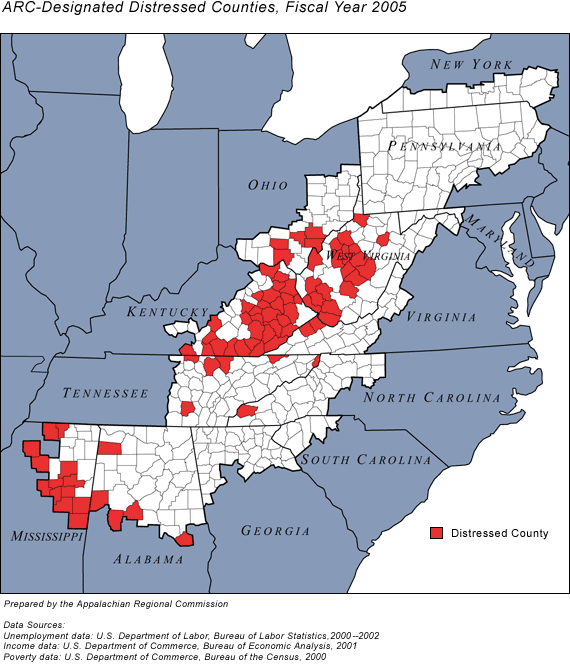Economic Redevelopment in Appalachia: The Appalachian Regional Commission
Anna Sokol
asokol@umich.edu
Last Modified:
April 19, 2005
Appalachia is a thirteen state region that stretches along the Appalachian mountain range from southwestern New York to northeastern Mississippi. Along with its spatial location, the area is characterized by its extensive historical reliance upon extractive resources, namely coal, as its main economic sector. While coal is no longer the largest employer for most counties in the region, the resource itself and the region's extractive history are still significant.
 |
As a result several factors in the late 1960s and 1970s, including of the decline of the coal industry in the region, raised awareness of dire socioeconomic conditions, and dwindling populations, the Appalachian Regional Commission was "established by Congress in 1965 to support economic and social development in the Appalachian Region" (www.arc.gov). According to the ARC website, the mission of the commission is "to be a strategic partner and advocate for sustainable community and economic development in Appalachia" (www.arc.gov). This site will elaborate upon some of the struggles the region faced and continue to endure, as well as the successes and failures of the economic development strategies in Appalachia.
|
|
Map
Source:
http://www.a-spi.org/AGF/
|
|
Distressed Counties
The area defined by the ARC that encompasses Appalachia is comprised of 406 counties. Under leadership and initiative from President Johnson's "War on Poverty," the process of identifying so-called "distressed" counties began. 219 of the 406 counties were identified as such, based on employment, poverty, and infrastructure data. Additionally, one in three Appalachians could be called "poor" based on national standards in 1965. (Jones, 2000) While significant strides have been made since the mid 1960s, one fifth of the counties in Appalachia are still considered distressed. The map below shows the geographic locations of these 82 counties, and an apparent pattern does seem to exist in their location and concentration south and west in the region.

|
|
Map Source: http://www.arc.gov/index.do?nodeId=2321 |
Other Economic Indicators
In addition to the distressed county categorization of land in Appalachia, other significant indicators and statistics exist to help better understand and measure the region. A total of 640,000 individuals lost their coal and agricultural related jobs between 1950 and 1960 alone, as Appalachia's industries switched their production type from bituminous coal to other, cleaner reserves. The job loss continued more recently, and between 1988 and 1998 42,000 individuals lost their coal related jobs. (Jones, 2000) Meanwhile, coal production has continued to rise in terms of number of tons, reaching 455 million tons in 1998. The relationship between job loss and increased production can be largely attributed to technological improvements in automated systems, with an increasing ratio in a ton of coal produced to a worker needed to produce that ton of coal. However, as production has increased the market price for coal has fallen to between $20 and $25 per ton, down from $40 per ton in the 1970s.
More information on the historical and current trends in Appalachia can be found at the Appalachian Regional Commission Website, www.arc.gov.
Economic Development Strategies
The formation of the ARC was perhaps one of the most fortuitous moves made in the region in recent history. Functional regional planning and development agencies are still rare, and were even more so in the mid 1960s when the ARC was founded. The ARC is a distributor of funds to programs that help improve the quality of life to one of the nation's most dire regions, and one which still exemplifies the very definition of "rural poverty." In addition to its economic improvement strategies, the ARC also invests in human capital improvements, such as early education programs and small business training initiatives. Another main focus of the ARC, particularly early in its existence, is to improve infrastructure needs of the community. Functional, paved roads were often not existent, and major federal funding improved access to and throughout the region tremendously. Today, the focus tends to be on clean water and functioning sewer systems, as the runoff and deposits from coal extraction led to substandard conditions at times. A table of the current programs offered by the ARC follows. Again, additional information can be gleamed from the ARC website.
| Economic and Human Development Activities help create jobs through education, physical infrastructure, civic development, business development, and health care projects. |
| The Distressed Counties Program provides special funding for the Region's poorest counties. |
| The Entrepreneurship Initiative helps communities assist entrepreneurs in starting and expanding local businesses. |
| The Local Development District (LDD) Program provides administrative support funds to the Region's 72 local development districts. |
| The Telecommunications Program is working to ensure that the information highway does not bypass the Appalachian Region. |
| The Transportation Program, which includes the Appalachian Development Highway System (ADHS), provides access to jobs, markets, health care, and education. |
| The Research and Technical Assistance Program tracks economic trends and emerging issues, undertakes program evaluation, and funds research. |
| The J-1 Visa Waiver Program enables health-care professionals from foreign countries to work in health manpower shortage areas in Appalachia. |
| The Business Development Revolving Loan Fund Program helps create and retain jobs by providing capital for economic development activities. |
| Information Source: http://www.arc.gov/index.do?nodeId=8 |
Conclusion
The ARC continues to be a major asset to this region of the United States. While extractive industries have taken their toll on the standard of living as well as the environmental quality of the region, the reliance and ingenuity to solve the problems is strong. The successes may seem small and incremental at times, however more abstract changes in the attitudes of residents in the area, while hard to measure, seems positive. Small businesses have increased, and reliance upon a single economic base is dwindling, albeit at times by force. Service related jobs are increasing in the region and tourism is becoming a possible economic development tool for the area. In March of 2005, National Geographic compiled an interactive travel website for the region, and published a segment in their National Geographic Travel magazine about Appalachia and the extensive eco-tourism resources available. While there is still much work to be done in the area, successes must not be overlooked in Appalachia. This beautiful and exciting region has great potential, and the ARC's economic development strategies will indeed help it capitalize upon this potential.
 |
Sources:
Jones, Diana Nelson. "Appalachia's War." The Pittsburgh Post Gazette. November 26, 2000 - November 28, 2000. <http://www.postgazette.com/headlines/20001126appalachiamainnat2.asp>
The Appalachian Regional Commission Website: http://www.arc.gov/index.jsp. Accessed April 15, 2005.
The Appalachian Ginseng Foundation Website: http://www.a-spi.org/AGF/. Accessed April 15, 2005.
The Atlantic Institute for Market Studies: http://www.atlantica.org/atlanticastory.asp?cmPageID=94. Accessed April 15, 2005.
The USGS Appalachian
Regional Science Commission Website: http://www.appalachianregionscience.usgs.gov/appal/pictures/html/pages/
landscape_jpg.htm. Accessed April 15, 2005. Last Modified August 13,
2002.